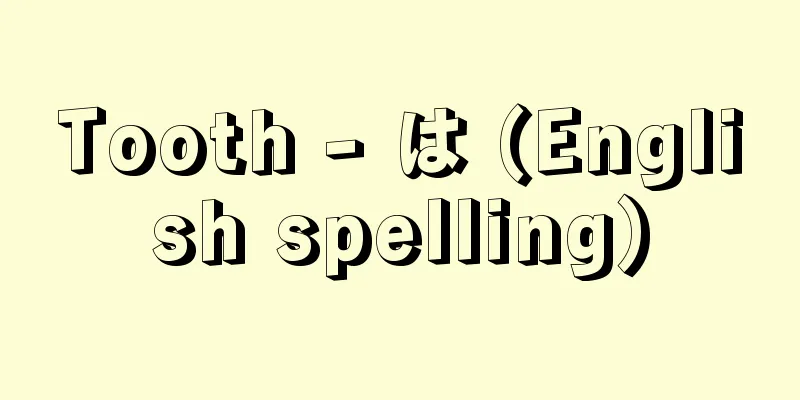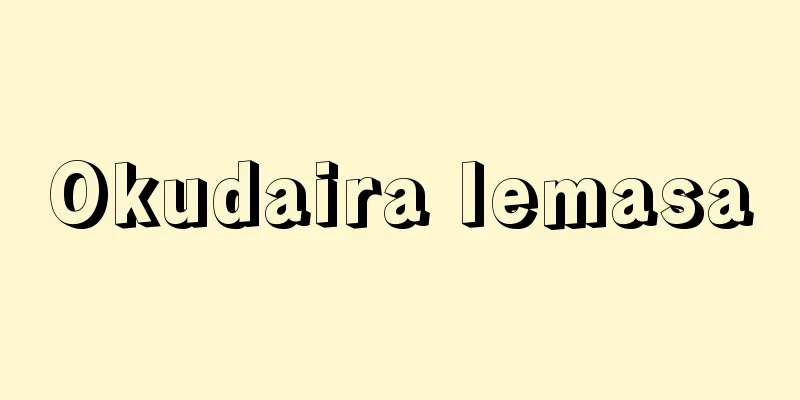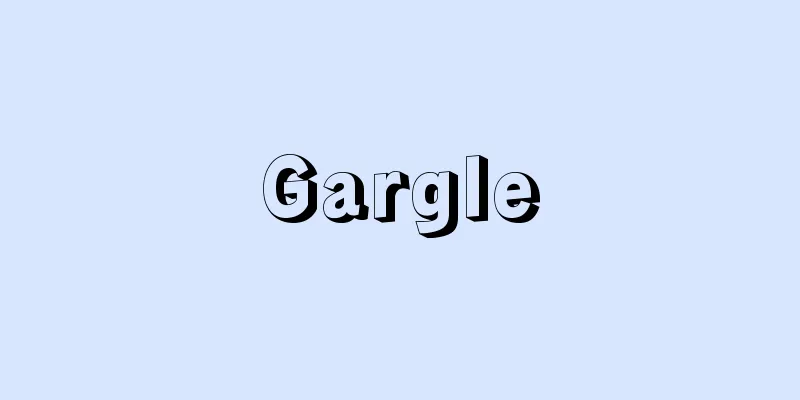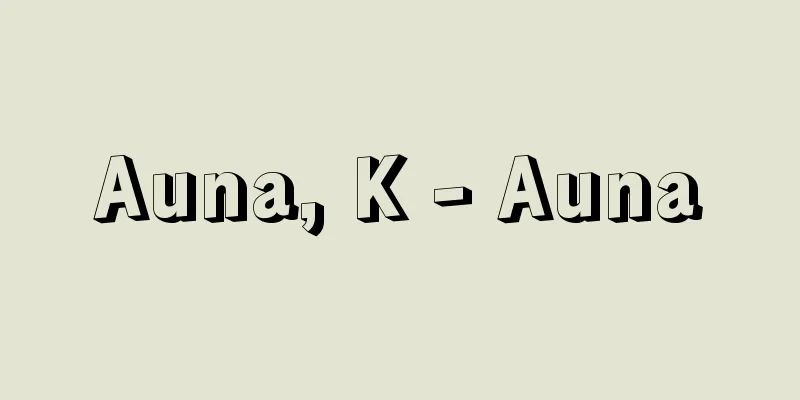Tooth - は (English spelling)

|
A hard tissue structure exposed in the oral cavity that provides functions such as aesthetics, pronunciation, and chewing. Teeth DevelopmentIn humans, the ectodermal oral mucosal epithelium thickens around the 5th to 6th week of fetal development, and penetrates vertically like a levee into the mesenchymal tissue to form the dental lamina. The enamel organ arises from this dental lamina, and together with the mesodermal dental papilla surrounded by the enamel organ, the tooth germ is formed. Around the 5th month of fetal development, enamel is produced from the ameloblasts in the inner layer of the enamel organ, dentin and dental pulp are produced from the odontoblasts in the surface layer of the dental papilla, and cementum and periodontal ligament are produced from the dental follicle that surrounds the tooth germ. After forming the crown of the tooth, the enamel organ proliferates deep inside as Hertwig's epithelial sheath, and erupts the tooth while forming the dentin of the root. Eventually, the Hertwig's epithelial sheath degenerates, and remains in the periodontal ligament as the Malassez epithelial remnants. [Masaaki Murai] Baby teethHuman teeth are replaced twice in a lifetime, a process known as dimorphic dentition. The first teeth to grow in the mouth and function during infancy are called "milk teeth," while the new teeth that grow in to replace them after they fall out are called "substitute teeth." From around age six, molars begin to grow in at the back of the milk dentition at the same time as the milk teeth are replaced, but molars are essentially the same type of teeth as milk teeth and can be thought of as an extension of them, and are also known as "additional teeth." Therefore, substitute teeth and additional teeth are collectively known as "permanent teeth." The deciduous teeth of both the upper and lower jaws consist of 20 teeth, arranged from the midline to the left and right: the deciduous central incisors, deciduous lateral incisors, deciduous canines, first deciduous molars, and second deciduous molars. In general, when we say front teeth or incisors, we are referring to the central incisors and lateral incisors, and when we say incisors, we are referring to the canines. In deciduous teeth, the mandibular deciduous central incisors usually start to grow (called eruption) first (at about 6 to 8 months of age), followed by the maxillary deciduous central incisors, mandibular lateral incisors, maxillary deciduous lateral incisors, first mandibular deciduous molars, maxillary first deciduous molars, mandibular deciduous canines, maxillary deciduous canines, second mandibular deciduous molars, and second maxillary deciduous molars. However, there are individual differences in the time and order of eruption, and a difference of 3 to 4 months is not abnormal. Milk teeth are whiter in color than permanent teeth, and the crowns of milk teeth are similar in appearance to the permanent teeth that follow, but they are generally smaller in size. However, the shape of milk molars is quite different from that of permanent teeth (premolars), and is more similar to molars. As children age, the roots of milk teeth become resorbed. Resorption begins at about age 4, starting with the milk central incisors, and all milk teeth fall out between the ages of 6 and 12. Milk teeth are weaker than permanent teeth, and are more susceptible to caries (tooth decay) due to a child's diet and lack of oral hygiene. Deciduous teeth not only have a negative effect on children both locally and systemically, but also have a large impact on the permanent teeth that follow, so prevention and early treatment are important. [Masaaki Murai] Permanent teethPermanent teeth, both upper and lower jaws, consist of 32 teeth in total, from the midline to the left and right: central incisors, lateral incisors, canines, first premolars, second premolars, first molars, second molars, and third molars (wisdom teeth). Generally, the term "back teeth" refers to the entire molar set. Of all permanent teeth, the first molars erupt earliest (at around age 6), and are therefore also known as the 6-year-old molars. The first molars are also known as the "key to occlusion" because they determine a certain contact relationship between the upper and lower jaw teeth, and are important teeth that function for a long period of time, lasting for several decades. However, because they erupt into the mouth during infancy, when children have no awareness of oral hygiene, they are susceptible to early caries. Therefore, it is important for parents, especially mothers, to be vigilant in preventing caries. The order of eruption of permanent teeth is mandibular first molar, maxillary first molar, mandibular central incisor, mandibular lateral incisor, maxillary central incisor, maxillary lateral incisor, mandibular canine, mandibular first premolar, maxillary first premolar, mandibular second premolar, maxillary second premolar, maxillary canine, mandibular second molar, maxillary second molar, but this order is influenced by early loss of preceding deciduous teeth, late retention, and the individual's health condition. Normally, 28 permanent teeth erupt by around 12 to 13 years of age. The third molar erupts the latest (around 17 to 20 years of age) and is often congenitally absent. Eruption abnormalities and morphological abnormalities are commonly seen, especially in the mandible. [Masaaki Murai] Tooth morphologyThe part exposed in the oral cavity, that is, the part covered by enamel, is called the crown, while the part covered by cementum within the alveolar bone is called the root. The boundary between them is called the neck. The shape of the crown varies from tooth to tooth, with incisors and canines being pyramidal, and molars being cubic. The number of roots also varies from tooth to tooth, with incisors and canines having a single root, premolars usually having a single root except for the maxillary first premolar, maxillary first premolars and mandibular molars having two roots, and maxillary molars having three roots. Note that the shape of both the root and crown of the third molar is not consistent and can take a variety of forms. [Masaaki Murai] Tooth structureTeeth are composed of four tissues: (1) Enamel Enamel is a hard tissue that covers the surface of the tooth crown and protects the dentin. It is the hardest tissue in the body (6-7 on the Mohs scale of hardness, about the same as quartz) and is composed mostly of inorganic matter (especially hydroxyapatite), with only about 4% organic matter and water. Enamel consists of enamel rods that are 3-5 micrometers thick and the interrod stroma that connects them together. The enamel rods run radially throughout the entire enamel layer from the surface of the dentin to the surface of the crown. In recent years, adhesive resins that bond to enamel rods have been developed, making it easier to repair substantial tooth loss due to caries and requiring less tooth grinding. (2) Cementum: A thin hard tissue (calcified tissue) that covers the surface of the tooth root, with a structure similar to that of fibrous bone. As we age, the cementum thickens at the tip of the tooth root. Cementum, together with the alveolar bone that is sandwiched between the periodontal ligament, is a retaining device for the Sharpey's fibers found in the periodontal ligament. The teeth are suspended within the alveolar bone by the Sharpey's fibers, and perform the masticatory function. (3) Dentin: This is the hard tissue that constitutes the main part of the tooth. It is covered by enamel at the crown and by cementum at the root. It is harder than bone, but its chemical composition is similar to bone, consisting of 70% inorganic and 30% organic matter. However, its microstructure is significantly different from that of bone tissue. Within dentin, countless tubules called dentinal tubules run radially from the surface of the pulp cavity to the surface of the tooth. On the pulp side of the dentinal tubules, odontoblasts that created dentin are arranged, and their projections extend deep into the dentinal tubules. There is a theory that nerves penetrate into some parts of the dentinal tubules, which is why pain is felt when the tooth is ground. However, when caries reaches the dentin and pain is felt, it is because stimuli are transmitted through the dentinal tubules to the pulp. Furthermore, as we age and our gums recede, exposing the tooth roots, the cementum in that area gradually disappears, exposing the dentin. When the dentin is exposed in this way, various stimuli in the mouth are transmitted to the tooth pulp, causing pain and sensitivity. As we age, the dentinal tubules become calcified, gradually narrowing and eventually closing off. Secondary dentin often forms on the walls of the dental pulp cavity, and as this calcification progresses, it is not rare for a person to no longer feel pain from external stimuli, even if the dentin is exposed in the mouth. (4) Dental pulp This is the connective tissue (soft tissue) that fills the pulp cavity, which is surrounded by dentin. Odontoblasts are arranged on the dentin surface. Dentin formation by odontoblasts continues throughout life, so the pulp cavity narrows gradually with age. The dental pulp is rich in blood vessels and nerves, but most of these enter only through the apical foramen, and once inflammation (pulpitis) occurs in the pulp, it is prone to circulatory disorders. Therefore, it is difficult to hope for the inflammation to heal naturally, and the entire pulp will die. When inflammation occurs in the dental pulp, the internal pressure of the pulp cavity, which is surrounded by hard tissue, increases abnormally, strongly irritating the pulp nerves and causing severe pain. [Masaaki Murai] Teeth alignmentWhen viewed from the occlusal surface, teeth are arranged in a horseshoe shape, which is called the "dental arch." The imaginary plane that joins the occlusal surfaces of the teeth on the upper and lower jaws is called the occlusal plane, but in reality it is not a flat surface; the occlusal plane of the upper jaw is convex, while that of the lower jaw is concave as it approaches the molar area. This curve is called the "curve of Spee" or "accommodative curve," and the presence of this curve allows the upper and lower teeth to maintain contact without any gaps during mandibular movement. The relative positions of the upper and lower teeth when biting normally is called "occlusion." In a normal occlusion, the teeth of the upper jaw protrude slightly further out than the teeth of the lower jaw. In the front teeth area, it is normal for the incisal edge of the lower jaw to bite against the lingual side of the upper jaw, but sometimes the incisal edge of the lower jaw goes forward of the upper jaw, which is called an inverted bite (mandibular prognathism). Mandibular prognathism is a type of malocclusion that is somewhat more common in Japanese people than in Westerners. The direction of tooth placement tends to be more distal (backward) at the root than at the crown. This is because teeth are always trying to tilt mesial (forward), so if one tooth is missing from a dental row, the teeth behind it will fall into the space where the tooth was missing. Therefore, dental treatment is necessary to maintain the dental row. [Masaaki Murai] Dental abnormalitiesAs humans began to cook food before eating, they had less opportunities to use their teeth, which led to a tendency for teeth to degenerate. This is manifested in the shape of teeth becoming smaller and the number decreasing. Some of the dental abnormalities that have been seen as a result of this trend include the following: (1) Morphological abnormalities Abnormally large teeth are called macrodontia, and abnormally small teeth are called microdontia. Macrodontia is sometimes seen in the upper central incisors, while microdontia is often seen in the wisdom teeth and upper lateral incisors. A protruding nodule may develop on the lingual surface of the front teeth or on the occlusal surface of the premolars, and is called an abnormal nodule. When the nodule develops, it has a pulp cavity inside, and when the nodule fractures, the pulp becomes exposed, often resulting in necrosis of the pulp. Two teeth can be attached to each other, and among them, when the teeth are connected by cementum after the formation of dentin, they are called ankylosed teeth, and when the teeth are joined before the formation of dentin, they are called fused teeth. These are mainly seen in the anterior region of the mandible. Long-term administration of tetracycline for severe neonatal jaundice or neonatal melena (gastrointestinal bleeding in newborns) can cause tooth discoloration, leading to aesthetic disorders. This is due to pigmentation occurring in the dentin through circulation during the tooth formation stage. Tooth discoloration can also occur due to caries, pulp bleeding, and pulp necrosis. When a tooth is bruised, its color changes because the nerves and blood vessels at the root apex are severed by external force, causing pulp necrosis. Tooth discoloration can also occur due to pulpitis and pulp necrosis, which is due to the blood in the pulp breaking down and the hemoglobin pigment being deposited on the tooth. (2) Abnormal number of teeth The most common location for supernumerary teeth is the upper anterior teeth, followed by the upper molar area. When there is one tooth on the midline, it is specifically called a midline tooth. Undertodontia is far more common than excess tooth count. In particular, the absence of wisdom teeth accounts for as much as 70% of cases. The next most commonly missing teeth after the wisdom teeth are the lateral incisors and second premolars. In extreme cases, all teeth may be missing, which is called congenital anodontia. Even if the number of teeth is normal, if the jawbone is small, the teeth cannot be arranged normally, and they may become crowded or become impacted (impacted teeth). According to one report, in recent years, the number of families feeding children soft food has increased, and children themselves are no longer required to chew, which has resulted in underdeveloped jaws and the increasing incidence of malocclusion. [Masaaki Murai] Teeth and Personal IdentificationTeeth, which are made up of three hard tissues - enamel, the hardest of all human tissues; dentin, which is harder than bone; and cementum - are highly resistant to physical and chemical destruction. Therefore, teeth are not easily affected by postmortem changes and can maintain their original shape for an extremely long period of time. Furthermore, the various findings on teeth vary greatly from person to person, and it is said that these differences are comparable to those of fingerprints. In the field of forensic medicine, teeth are extremely valuable as indicators for personal identification. They are particularly effective in the case of skeletal remains, large fires involving many deaths at once and severe damage to the bodies, and aircraft accidents. Forensic dental examinations include checking the state of tooth eruption and replacement, abnormalities in the number of teeth (presence or absence of supernumerary teeth, missing teeth), morphological abnormalities (presence or absence of macrodontia, small teeth, abnormal tubercles on molars), positional abnormalities (position and degree of interdental spacing, displaced teeth, rotated teeth, inclined teeth), the presence and degree of caries, treatment (fillings, prosthetics), attrition and wear, and an investigation of the occlusion. In treatment, the dentist's characteristics can be seen in the method used, and various information can be obtained, such as an estimate of the patient's lifestyle from the materials used. In addition, since the timing of tooth eruption and replacement is almost constant, it is possible to estimate the patient's age quite accurately, between 0 and 20 years. From the degree of tooth wear, age estimates are often made between the 20s and 50s (in intervals of about 10 years). It is generally said that women's teeth are smaller and shorter, but this is relative, and it is quite difficult to determine the patient's gender, especially from a single isolated tooth. In addition, ABO blood type can be determined from teeth with about 20 milligrams of dentin and cementum, and about 1 milligram of dental pulp. [Junichi Kotani] Teeth in animalsA digestive appendage in the oral cavity of vertebrates. Invertebrates also have organs called "teeth," but strictly speaking, the term "teeth" refers only to vertebrates. However, even among vertebrates, the dentition of cyclostomes such as lampreys and anuran amphibians' tadpoles is a keratinous formation on the epidermis, and is called a keratinous dentition, which is different from true teeth. True teeth have a fibrous connective tissue pulp inside, surrounded by dermal tooth tissue (dentin). Blood vessels and nerves penetrate the dental pulp. The cavity filled by the dental pulp is called the dental pulp cavity. The part exposed to the oral cavity is made of epidermal enamel and is called the tooth crown. In bony fish and above, the base of the tooth (root) is covered with cementum. Because teeth are such hard organs, they tend to remain as fossils, and fossilized teeth are often used to infer the evolution of vertebrates. Among living animals, sturgeons and their relatives, amphibian frogs, and reptile turtles have poorly developed and degenerated teeth. Additionally, birds currently have no teeth. Lower jawless fish, the cyclostomes, do not have teeth, but fish have many teeth that are distributed widely in the oral cavity and pharynx. As animals become more advanced, the number of teeth decreases and their distribution becomes increasingly limited. Crocodiles and mammals only have teeth in the jaw area, and mammals have a significantly reduced number of teeth compared to other areas. The process of replacing teeth is called molting. In vertebrates below reptiles, teeth are replaced throughout their life (polymoltosis, polydontosis). In mammals, tooth replacement occurs only once (moltosis, didontosis). In this case, the first tooth is called a deciduous tooth or deciduous tooth, and the next tooth is called a permanent tooth. Note that some mammals do not undergo tooth replacement (nonmoltosis, endodontosis). In addition, mammals other than toothed whales and poisonous snakes among reptiles are heterodont, with morphologically differentiated teeth, while other animals are homodont. In heterodont species, the shape of the teeth changes in various ways, and as a special example, the venomous fangs of poisonous snakes are also modified teeth. The tusks of elephants and walruses are modified incisors and canines, respectively. There are various ways in which the teeth are attached to the jawbone. In many bony fishes, the teeth are attached to the apex of the jawbone (acrocephaly). In frogs, newts, and many reptiles, the teeth are attached to the inside surface of the jawbone (facet-shaped). In crocodiles and mammals, the teeth are inserted into grooves or holes (dental alveoli) in the jawbone (alveolar-shaped). In cartilaginous fishes such as sharks, the teeth are attached to the jaw cartilage by ligaments. [Sumio Takahashi] [References] | | | | Orthodontics | | |©Shogakukan "> Teeth Development The diagram shows the dentition in the upper jaw . ©Shogakukan Primary and permanent teeth ©Shogakukan "> Periodontal tissue The diagram shows the relationship between the jawbone and permanent teeth . ©Shogakukan Occlusion and tooth morphology © Satoshi Shimazoe Animal Tooth Structure (Mammals) © Satoshi Shimazoe Heterodontity and homodontity of animal teeth © Satoshi Shimazoe The connection between animal teeth and jaw bones © Satoshi Shimazoe Differences in molars due to differences in animal diets Source: Shogakukan Encyclopedia Nipponica About Encyclopedia Nipponica Information | Legend |
|
口腔(こうくう)内に露出している硬組織の構造物で、審美性、発音、そしゃく等の機能を営む。 歯の発生ヒトでは、胎生期5~6週ごろに外胚葉(がいはいよう)性の口腔粘膜上皮が厚くなり、堤防のように垂直に間葉組織内に進入し、歯堤を形成する。この歯堤からエナメル器を生じ、エナメル器に囲まれた中胚葉性の歯乳頭とともに歯胚を形成する。胎生期5か月ごろになると、エナメル器の内層にあるエナメル芽細胞(がさいぼう)からエナメル質が、歯乳頭の表層にある象牙(ぞうげ)芽細胞から象牙質と歯髄(しずい)が、また歯胚を包む歯小嚢(のう)からセメント質と歯根膜が生ずる。エナメル器は歯冠部を形成したのち、ヘルトウィヒ上皮鞘(しょう)として深部に増殖し、歯根の象牙質を形成しながら歯を萌出(ほうしゅつ)させる。やがてヘルトウィヒ上皮鞘は退化して、歯根膜中にマラッセ上皮遺残として残る。 [村井正昭] 乳歯ヒトの歯は生涯で二度生え変わり、これを二生歯性とよぶ。最初に口の中に生えそろい、乳幼児期にその機能を営むものを「乳歯」といい、乳歯脱落後、新たに生え変わるものを「代生歯」という。6歳ごろから、乳歯の生え変わりと同時に、乳歯列の後方に大臼歯(だいきゅうし)が生えてくるが、大臼歯は本来乳歯と同種のもので、その延長線上にあるものとも考えられ、「加生歯」ともよばれる。したがって、代生歯と加生歯をあわせて「永久歯」という。 乳歯は、上下顎(がく)とも、正中より左右へ、乳中切歯、乳側切歯、乳犬歯、第一乳臼歯、第二乳臼歯の合計20本よりなる。一般に前歯(ぜんし、まえば)、門歯というときは中切歯と側切歯をさし、糸切り歯というときは犬歯をさす。乳歯では、通常、下顎乳中切歯がいちばん早く(生後約6~8か月)生え始め(萌出という)、次に上顎乳中切歯、下顎乳側切歯、上顎乳側切歯、下顎第一乳臼歯、上顎第一乳臼歯、下顎乳犬歯、上顎乳犬歯、下顎第二乳臼歯、上顎第二乳臼歯の順に萌出する。しかし、萌出時期や、順序には個体差があり、3~4か月の差異は異常ではない。 乳歯は、永久歯に比べて色が白く、歯冠の外形は後続の永久歯に似ているが、大きさは全体的に小さい。ただし、乳臼歯の形は永久歯(小臼歯)とはかなり異なっており、むしろ大臼歯に似ている。乳歯では、年齢が進むと歯根の吸収がみられる。4歳ぐらいから乳中切歯より吸収が始まり、6歳から12歳ぐらいまでの間にすべての乳歯は脱落する。乳歯は永久歯に比べると歯質が脆弱(ぜいじゃく)であるうえ、小児の食性や口腔清掃の不足などによってう蝕(しょく)(むし歯)にかかりやすい。乳歯う蝕は、小児に局所的あるいは全身的悪影響を与えるばかりでなく、後続の永久歯に対する影響も大きいので、予防および早期治療がたいせつである。 [村井正昭] 永久歯永久歯は、上下顎とも、正中より左右へ、中切歯、側切歯、犬歯、第一小臼歯、第二小臼歯、第一大臼歯、第二大臼歯、および第三大臼歯(智歯(ちし)、親知らず)の合計32本よりなる。一般に奥歯というときは大臼歯全体をさしている。 永久歯では、第一大臼歯がもっとも早く(6歳ごろ)萌出するので、6歳臼歯ともよばれる。また、第一大臼歯は、上下顎の歯列の一定の接触関係を規定するということから「咬合の鍵(こうごうのかぎ)」ともよばれ、数十年の長期間にわたって機能を営むたいせつな歯である。しかしながら、口腔衛生観念のない幼児期に口腔内に萌出するということから、早期にう蝕にかかりやすい。したがって、保護者、とくに母親の注意によって、う蝕にかからないようにすることがたいせつである。 永久歯の萌出順序は、下顎第一大臼歯、上顎第一大臼歯、下顎中切歯、下顎側切歯、上顎中切歯、上顎側切歯、下顎犬歯、下顎第一小臼歯、上顎第一小臼歯、下顎第二小臼歯、上顎第二小臼歯、上顎犬歯、下顎第二大臼歯、上顎第二大臼歯の順となるが、先行乳歯の早期喪失、晩期残存、個体の健康状態によってこの順は左右される。永久歯は、普通には12~13歳ごろまでに28歯が萌出する。なお、第三大臼歯は萌出がもっとも遅く(17~20歳ごろ)、先天的に欠如することも多い。萌出状態の異常、形態の異常等は、とくに下顎に多くみられる。 [村井正昭] 歯の形態口腔内に露出している部分、つまりエナメル質で覆われた部分を歯冠といい、歯槽骨(しそうこつ)内のセメント質で覆われた部分を歯根という。その境界は歯頸(しけい)といわれる。歯冠の形態はそれぞれの歯により異なっており、切歯および犬歯は四角錐(しかくすい)状、臼歯は立方体状をしている。歯根の数も歯によって異なり、切歯および犬歯は単根、小臼歯も通常、上顎第一小臼歯を除き単根、上顎第一小臼歯および下顎大臼歯は2根、上顎大臼歯は3根である。なお、第三大臼歯では歯根、歯冠の形態はともに一定でなく、種々の形態をとる。 [村井正昭] 歯の構造歯は、次に述べる四つの組織から構成されている。 (1)エナメル質 歯冠の表面を覆い、象牙質を保護する硬組織で、身体のなかではもっとも硬く(モースの硬度で6~7度。水晶と同程度)、ほとんどが無機質(とくにハイドロキシアパタイト)からなり、有機質と水分は4%程度含まれるにすぎない。エナメル質は、3~5マイクロメートルの太さをもつエナメル小柱と、これを互いに結合する小柱間質とからなる。エナメル小柱は、象牙質の表面から歯冠の表面に向かってエナメル質全層にわたって放射状に走っている。近年、エナメル小柱と結合する接着性レジンが開発され、う蝕による歯の実質欠損の修復が簡単にでき、歯をあまり削らないですむようになった。 (2)セメント質 歯根の表面を覆う薄い硬組織(石灰化組織)で、線維に富む骨に似た構造となっている。加齢とともに、セメント質は歯根先端部で厚くなる。セメント質は、歯根膜を挟んで存在する歯槽骨とともに、歯根膜中にみられるシャーピー線維の保持装置である。歯は、このシャーピー線維によって歯槽骨内につり下げられる形となり、そしゃく機能を営んでいる。 (3)象牙質 歯の組織の主体をなす硬組織で、歯冠部ではエナメル質により、歯根部ではセメント質により覆われている。硬さは骨よりも硬いが、化学的組成は骨に類似し、無機質70%と有機質30%とからなる。しかし、微細構造は骨組織と著しく異なる。象牙質内には、歯髄腔(しずいくう)面から歯の表面に向かって、象牙細管とよばれる無数の細管が放射状に走っている。象牙細管の歯髄側には、象牙質をつくってきた象牙芽細胞が配列しており、象牙細管内の深くまでその突起を出している。象牙細管内の一部には神経が進入しており、これによって歯を削るときの痛みが感じられるという説もある。しかし、う蝕が象牙質に達して痛みを感じるようになるのは、刺激が象牙細管を伝わって歯髄に達するためである。また、年をとって歯肉が退縮し、歯根が露出してくると、その部分のセメント質が徐々に消失し、象牙質が露出するようになる。このように象牙質が露出すると、口の中のいろいろな刺激が歯髄に伝わり、しみたり痛んだりするようになる。象牙細管は、加齢とともに石灰化が進み、だんだんと細くなり、ついには閉鎖されることもある。なお、歯髄腔壁にはしばしば二次象牙質が形成され、これらの石灰化の進行によって、たとえ象牙質が口の中に露出しても、外来刺激による痛みを感じなくなることが少なくない。 (4)歯髄 周囲を象牙質に囲まれている歯髄腔を満たす結合組織(軟組織)である。象牙質面には象牙芽細胞が配列する。象牙芽細胞による象牙質形成は、生涯を通じて続けられるため、歯髄腔は加齢とともにしだいに狭くなる。歯髄は血管と神経に富んでいるが、これらの大部分の進入経路は根尖孔(こんせんこう)のみであり、いったん歯髄に炎症(歯髄炎)がおこると、循環障害をおこしやすい。したがって、炎症の自然治癒を望むことはむずかしく、歯髄全体が死んでしまうこととなる。歯髄に炎症がおこると、硬組織に囲まれている歯髄腔の内圧が異常に高まり、歯髄神経が強く刺激され、激痛を生じるようになる。 [村井正昭] 歯の並び方歯は、咬合面からみると馬蹄(ばてい)形に並んでおり、これを「歯列弓」という。また、上顎、下顎のそれぞれの歯の咬合面を連ねた仮想平面を咬合平面とよぶが、実際には平面ではなく、咬合平面は臼歯部にいくにしたがって上顎は凸彎(とつわん)、下顎は凹彎を示している。この彎曲は「スピーの曲線」あるいは「調節彎曲」とよばれ、この彎曲の存在により、下顎運動の際には上下の歯がすきまなく接触を保ちうる。 普通にかんだ状態の上下歯列の位置関係を「咬合」という。正常な咬合では、上顎の歯が下顎の歯よりもすこし外側へはみだしている。前歯部では、下顎の切縁(せつえん)が上顎の舌側面にかむのが正常であるが、逆に下顎の切縁が上顎よりも前にいくことがあり、これを反対咬合(下顎前突)とよぶ。下顎前突は、欧米人に比べて日本人にやや多くみられる不正咬合の一種である。 歯の植立方向は、歯冠よりも歯根のほうが遠心(後方)に傾く傾向がある。これは、歯はつねに近心(前方)へ傾こうとしているためで、歯列のなかの1本の歯がなくなると、その後方の歯は、歯のなくなった空間に倒れ込んでくる。したがって、歯列を保つためには、歯科治療が必要となるわけである。 [村井正昭] 歯の異常人間は食物を調理してから摂取するようになったことから、歯を使用する機会が減少し、それに伴って歯の退化傾向がみられるようになった。その具体的な現れ方は、歯の形態の矮小(わいしょう)化と数の減少である。こうした傾向のなかでみられる歯の異常には、次のようなものがある。 (1)形態の異常 歯の大きさが異常に大きいものを巨大歯、小さいものを矮小歯という。巨大歯は、ときに上顎中切歯にみられることがあり、矮小歯は、智歯(ちし)や上顎側切歯によくみられる。 前歯の舌側面や小臼歯の咬合面に突起状の結節が生じることがあり、これを異常結節とよぶ。結節の発達したものでは、中に歯髄腔をもっており、結節が破折すると歯髄が露出し、歯髄の壊死(えし)を招くことが多い。 二つの歯がくっつくことがあり、そのうち、象牙質形成後にセメント質によって結び付けられたものを癒着歯、二つの歯がまだ未完成のうちに結合したものを癒合歯という。これらは主として下顎前歯部にみられる。 重症な新生児黄疸(おうだん)、新生児メレナ(新生児の消化管出血)に対して長期にわたるテトラサイクリン投与などを行うと、歯に着色がおこり、審美障害を招くことがある。これは、歯の形成期に、循環を通じて象牙質に色素沈着を生じたためである。また、う蝕、歯髄出血、歯髄壊死などによっても歯の変色を生じる。歯を打撲したのち、歯の色が変わってくるのは、外力によって根尖(こんせん)での神経、血管が切断され、歯髄壊死がおこったためである。このほか、歯髄炎や歯髄壊死によっても歯の変色が生じるが、これは、歯髄中の血液が分解され、ヘモグロビンの色素が歯に沈着するためである。 (2)歯数の異常 過剰歯の出現部位は上顎の前歯部がもっとも多く、ついで上顎大臼歯部となる。正中線上に1本あるときには、とくに正中歯とよばれる。歯数不足は歯数過剰に比べると、はるかに頻度が高い。とくに智歯の欠如は70%にも上る。智歯に続く欠如部位としては、側切歯、第二小臼歯がある。極端な場合は全歯が欠如することがあり、これは先天性無歯症とよばれる。 また、歯数が正常でも、顎骨が小さいと、歯は正常に配列することができず、叢生(そうせい)となったり埋伏したり(埋伏歯)する。ある報告によれば、近年、子供に軟らかい食物を与える家庭が増えたことから、子供自身のそしゃく運動があまり必要とされなくなり、その結果、顎の発育不全をきたし、歯列不正が多くみられるようになったという。 [村井正昭] 歯と個人識別人体組織のなかでもっとも硬いエナメル質、骨より硬い象牙質、セメント質の3硬組織から構成される歯は、物理的・化学的破壊に対して強い抵抗性をもつ。したがって、歯は死後変化の影響を受けにくく、きわめて長期にわたって原形を保持することができる。また、個人における歯の各種所見は千差万別で、その差異は指紋にも匹敵するとまでいわれ、法医学分野では個人識別の指標としてきわめて重要な価値をもっている。とくに白骨死体、一度に多数の死者発生を伴い、死体損壊の高度な大火災、航空機事故の際には威力を発揮する。法医学的な歯の検査としては、歯の萌出・交代(交換)の状態、歯数の異常(過剰歯、欠如歯の有無)、形態の異常(巨大歯、矮小歯、大臼歯の異常結節の有無)、位置の異常(歯間離開、転位歯、回転歯、傾斜歯の位置・程度)、う歯(むし歯)の有無・程度、治療処置(充填(じゅうてん)、補綴(ほてつ))、咬耗(こうもう)・磨耗の状態などの所見、および咬合状態の調査があげられる。 治療処置では、その方法に歯科医の特徴がみられるほか、使用材料からの生活程度の推定といった種々の情報が得られる。また、歯の萌出・交代時期はほぼ一定していることから、かなり正確に0~20歳くらいの間の年齢推定が可能となる。歯の咬耗の程度からは、20歳代から50歳代までの年齢推定(約10歳間隔)が行われることが多い。一般に女性の歯のほうが小さく、短いといわれるが、これは相対的なもので、とくに遊離した1本の歯からの性別推定はかなり困難である。また、歯からの血液型は、象牙質、セメント質では約20ミリグラム、歯髄では約1ミリグラムあればABO式血液型が判定できる。 [小谷淳一] 動物における歯脊椎(せきつい)動物の口腔(こうこう)内にある消化器官の付属体の一つ。無脊椎動物にも「歯」とよばれる器官があるが、厳密な意味での歯とは脊椎動物のもののみをさす。しかし脊椎動物でも、ヤツメウナギなどの円口類や無尾両生類のオタマジャクシなどの歯状物は、表皮の角質形成物であって真の歯とは異なり、角歯(かくし)とよばれる。真の歯は内部に繊維性結合組織の歯髄をもち、それを囲んで真皮性の歯質(象牙質(ぞうげしつ))がある。歯髄には血管と神経が入り込んでいる。歯髄が満たす腔所を歯髄腔という。口腔に露出する部分は、表皮性のエナメル質からなり、歯冠という。硬骨魚類以上では歯の基部(歯根)はセメント質で覆われている。歯はこのように硬質な器官であるために、化石として残りやすく、化石となった歯は脊椎動物の進化を推定するのによく利用される。 現生動物では、チョウザメなどの仲間、両生類のカエルや爬虫(はちゅう)類のカメなどが、歯の発達が悪く退化している。また、現在鳥類には歯がない。あごのない下等な魚類の円口類には歯はないが、魚類は多数の歯をもち、口腔や咽頭(いんとう)内に広く分布している。高等動物になるにつれて歯の数は減少し、分布もしだいに限られたものになる。ワニや哺乳(ほにゅう)類ではあごの部分にのみ歯が生え、哺乳類ではほかに比べて歯の数が著しく減っている。 歯が生え換わることを換歯という。爬虫類以下の脊椎動物では一生の間歯が生え換わる(多換歯性、多生歯性)。哺乳類では一度だけ換歯がおこる(換歯性、二生歯性)。この場合、最初の歯を乳歯または脱落歯といい、次の歯を永久歯という。なお、一部の哺乳類では換歯がおこらない(不換歯性、一生歯性)。また、ハクジラを除く哺乳類や爬虫類の有毒ヘビ類は、形態的に分化した歯をもつ異歯性であるが、そのほかの動物は同歯性である。異歯性の種では歯の形態はさまざまに変化しているが、特殊な例としては毒ヘビの毒牙(どくが)も歯の変形したものである。またゾウやセイウチの牙(きば)は、それぞれ門歯や犬歯が変化したものである。 顎骨(がくこつ)と歯の結合には種々の様式がある。多数の硬骨魚類では、顎骨の頂端に歯が結合する(端生)。カエルやイモリ、多数の爬虫類では、顎骨の内面に歯が結合する(面生)。ワニや哺乳類では、顎骨の溝または穴(歯槽)に歯が挿入されている(槽生)。これに対し、サメなどの軟骨魚類では、歯はあごの軟骨に靭帯(じんたい)によって結合している。 [高橋純夫] [参照項目] | | | | | | |©Shogakukan"> 歯の発生 図は上顎における歯列を示す©Shogakukan"> 乳歯と永久歯の歯列 ©Shogakukan"> 歯周組織 図は顎骨と永久歯との関係を示す©Shogakukan"> 歯列の咬合状態と各歯の形態 ©島添 敏"> 動物の歯の構造(哺乳類) ©島添 敏"> 動物の歯の異歯性と同歯性 ©島添 敏"> 動物の歯と顎骨との結合様式 ©島添 敏"> 動物の食性の違いによる臼歯の差 出典 小学館 日本大百科全書(ニッポニカ)日本大百科全書(ニッポニカ)について 情報 | 凡例 |
>>: Leaf - (English spelling) leaf
Recommend
Respiratory acidosis
…The pH of body fluids is normally maintained at ...
Funatsu Denjihei
Year of death: June 15, 1898 Year of birth: Tempo ...
Chronicles of Japan
The title of a song from the Kōwaka dance series. ...
Solar power generation - solar thermal power generation
This is a power generation method that efficientl...
Onomatopoeia - Onomatopoeia
Words used to describe states that are not directl...
Joruri - Joruri
A type of Japanese music. A type of storytelling ...
Bundessoziale
...The methods of handling cases and legal theori...
Python molurus; Indian python
It is a member of the order Lacertidae, family Pyt...
Gypsy Music - Gypsy Music
A unique folk music developed and popularized by t...
Ohara school
It is one of the three major schools of ikebana, ...
Casting - Imono (English spelling)
This refers to metal products (castings) made by ...
Dangerous painting - Dangerous painting
A term used in ukiyo-e. A type of ukiyo-e painting...
Approval - Saika
〘noun〙① To exercise discretion and give permission...
Quaternary ammonium salt
…The general formula is NR 4 X. It is also called...
Gassan Castle
A mountain castle built on Mt. Gassan in Hirose, Y...









